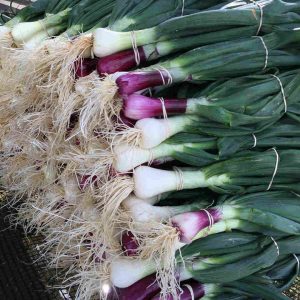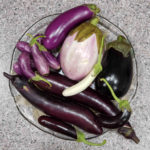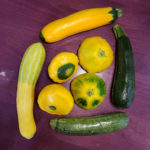Onions
Botanically, the allium family is the king of aromatics. Onions are the most common allium in the culinary world. At the grocery, you can generally find several types of onions on the shelf: yellow, sweet, white, and red. If a recipe generically calls for an onion, a yellow onion is the one to use. They contain enough sulfur compounds to bring complexity to savory dishes, and enough sugar to naturally provide some sweetness. Sweet onions, such as the Vadalia and the Walla Walla, are very popular. They have a lower sulfur concentration, so they have less bite. It’s not that they have a lot more sugar, but the milder flavor makes their sugars more prominent. They are a good option when raw onions are called for, they don’t add much aromatic complexity when cooking savory dishes. White onions are the most pungent of the group. They are the onion of choice for many Latin dishes. Red onions are also quite pungent, but they look so pretty when sliced so they are often used in raw presentations. Sometimes the bite is desirable, but you can also tame the bite by thinly slicing them and then soak them in ice water for 20 minutes. A quick pickle is another option for red onions.
Garlic
Garlic is also an allium. You usually don’t have much of a selection in garlic at the grocery store. Of course, there’s the fresh bulbs and the diced stuff in jars. Just say no to the latter. You may find peeled, fresh garlic cloves in the refrigerated section. That’s a much better option if you are looking for convenience. You may also find elephant garlic next to the regular garlic. Elephant garlic is actually a closer relative to the leek than it is to regular garlic. Flavor wise, it is analogous to the sweet onion vs the yellow onion. Elephant garlic has less aromatic compounds, so it tastes milder and sweeter than regular garlic. Ounce for ounce, it will deliver less complexity to the final savory dish. If you are a gardener or have a good farmers’ market, you have other garlic options. Green garlic is simply a young garlic plant which looks like an extra-large scallion or a small leek. The immature bulb has not yet divided into cloves. It’s like a single giant clove that you don’t need to peel. The green part of the plant is also useful with a mild garlic flavor. I love to use green garlic. The bottom gets used much like regular garlic, and the chopped greens go into the dish relatively late in the cooking process. As the garlic plant matures, as long as it is a hard neck variety, it will produce a flowering stalk called a scape. The scapes start out as a curley Q which will eventually straighten and bloom. Blooming takes energy away from the bulb, so the scapes are harvested, and they are delicious. Think something with the texture of tender asparagus but with a delightful mild garlic flavor. Throw them on the grill, chop them to include in a stir fry, or make them the basis of a pesto. Finally, of course, the mature garlic bulbs are eventually ready for harvest.
Shallots
Shallots look like a cross between onions and garlic. With their dry peel intact, they look like a slender onion, but when you peel away the outer shell you generally find a large clove and a small clove, each requiring more peeling. Shallots also have a flavor which is a bit of a cross between onion and garlic. Shallots are common in French dishes.
Leeks
Leeks look like a huge scallion. They are in the allium family, but they don’t form a bulbous root. They are almost cylindrical. Compared to onions, the flavor of a leek is mild and earthy. Because they are mild, they aren’t normally used as an aromatic component, but instead play a central role in the dish. Think of the central role onions play in French onion soup. That’s the type of role leeks play in most leek dishes. Leeks are tricky to clean because dirt is mounded up against their sides as they grow to lengthen the white portion at their base. The dirt can get in between the concentric rings as the leaves grow out. Most recipes call on only using the white and tender light green portion of the leek. There is a widespread idea that the dark green part of a leek is too tough to eat, and only useful as a component in stock. But I find that the leek green is quite useful and tasty. 1) Cut it thinly, against its fibrous grain. 2) As with many ingredients that start tough, long slow cooking is the great tenderizer. If you’ve been throwing away leek greens because that’s what the recipe says to do, give them a try. Throw them into the cooking process earlier than the rest of the leeks, 5 to 10 minutes.
Scallions
Scallions are quite mild compared to most alliums. They are generally eaten raw or just lightly cooked. They are central to Asian cooking, as part of the Asian trinity, along with ginger and garlic. Unlike most aromatics, they should be added towards the end of the cooking process, to maintain their flavor and texture. Often, they are added after the dish has been taken off the heat or during the plating stage. The whole scallion is edible, but recipes will often specify different uses for the white part and the green part. One underused option that you should definitely try is to simply sauté them whole in butter, like Edna Lewis describes in The Taste of Country Cooking.
Ramps
There are several other less common alliums that you may find at the market, but let’s end this discussion with ramps. Ramps are a native North American allium, foraged wild from the forest in the spring. Historically, they were used by the Cherokee and were a spring staple in Appalachian kitchens. Historically they were a humble ingredient gathered for free from the woods, but now they are a hot commodity in the foodie world. They are popular and expensive because they are scarce. They have not been cultivated. They are only available for a short period in the spring. To get them, you must be a forager, know someone who forages, or have a forager presence at your market. There is also concern of over-harvesting. It takes 4 years for the ramp to mature and flower. The entire plant is edible. The bulb, stems and leaves present varying oniony/garlicy flavor. If you are lucky enough to come across a bunch of ramps or two, make them solo stars of a dish. Don’t make them compete with other strong flavors. Make sure the subtle differences between ramps and other alliums is apparent in the dish. Sauté them whole in olive oil with a pinch of salt and pepper to make a stand-alone side. Make a pesto to dress a simple pasta or as a base for a simple cheese pizza. Incorporate them into buttermilk biscuits.



